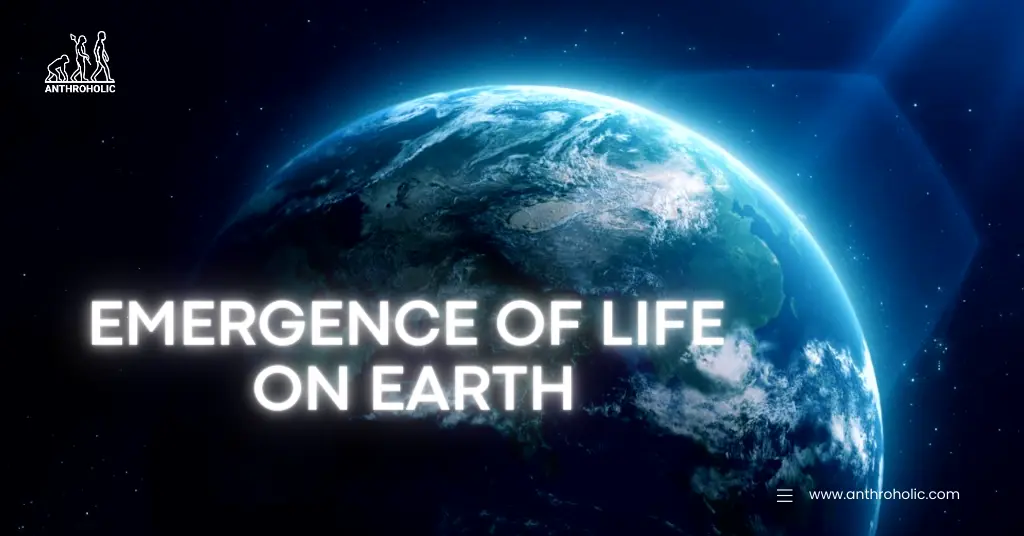AI Answer Evaluation Platform Live Now. Try Free Answer Evaluation Now
Emergence of Life on Earth
The emergence of life on Earth is an expansive topic that dives into the very origins of our existence. Around 4.6 billion years ago, our planet formed in the chaotic heart of a stellar nursery [1]. Earth’s initial conditions were inhospitable for life as we understand it today, characterized by extreme heat, pervasive volcanic activity, and a lack of oxygen in the atmosphere.

The Formation of Organic Molecules
The “primordial soup” theory posits that life’s building blocks formed in the Earth’s early oceans, fueled by atmospheric gases and the energy from lightning or volcanic eruptions [2].
- Amino acids: Vital components of proteins and enzymes
- Nucleotides: Forming RNA and DNA
- Lipids: Building blocks of cellular membranes
Prebiotic Evolution
The transition from non-living to living was gradual, involving complex, self-organizing systems of molecules [3]. Crucial steps in this process included:
- Self-replication: molecules like RNA could make copies of themselves.
- Encapsulation: the formation of “protocells,” precursors to modern cells.
The Archean Eon and the Dawn of Life
During the Archean Eon (4 to 2.5 billion years ago), life as we know it began to take shape.
First Life Forms: The Archaea and Bacteria
The first indisputable evidence of life comes from fossils of microorganisms dated around 3.5 billion years ago [4]. These organisms fall into two categories:
- Archaea: Known for their ability to withstand extreme conditions.
- Bacteria: The most diverse and widespread group of organisms on Earth.
The Emergence of Photosynthesis
The emergence of photosynthesis dramatically changed Earth’s atmosphere by increasing its oxygen content, leading to the Great Oxidation Event approximately 2.4 billion years ago [5].
| Key Organism | Function | Result |
|---|---|---|
| Cyanobacteria | First photosynthesizers | Oxygenation of the Earth’s atmosphere |
The Proterozoic Eon and the Development of Multicellular Life
During the Proterozoic Eon (2.5 billion to 541 million years ago), significant biological advancements occurred.
Evolution of Eukaryotes
Around 2 billion years ago, the first eukaryotic cells (cells with a nucleus) appeared, likely as a result of endosymbiosis, where one organism engulfs another, leading to mutual survival.
The Emergence of Multicellular Life
By about 1 billion years ago, the first multicellular organisms had emerged, paving the way for greater biological complexity.
The Phanerozoic Eon and the Flourishing of Complex Life
Cambrian Explosion
Approximately 541 million years ago, the Cambrian Explosion marked a period of rapid diversification of multicellular life during the Paleozoic Era. This period is characterized by the emergence of most major animal phyla, including the first appearance of complex organisms with shells and other hard body parts.
The Rise of Land-Dwelling Organisms
By the end of the Cambrian period, the first primitive plants had begun to colonize the land. This colonization paved the way for terrestrial life, including the first land-dwelling arthropods and, eventually, the first amphibians.
Evolution of Dinosaurs and Mammals
During the Mesozoic Era (230 to 65 million years ago), dinosaurs dominated the land. Around the same time, the first mammals appeared. While initially small and nocturnal, mammals would ultimately take over the Earth following the extinction of the dinosaurs at the end of the Cretaceous period.
Emergence of Humans
Primate Evolution
The first primates evolved around 65 million years ago, providing the foundation for human evolution.
Hominid Evolution
The evolution of the human lineage, or hominids, began approximately 6-7 million years ago with early species such as Sahelanthropus tchadensis. This lineage includes several species, the most recent of which is Homo sapiens.
| Key Hominid | Time Period | Notable Characteristics |
|---|---|---|
| Australopithecus afarensis | 3.9-2.9 million years ago | Bipedal, small brain |
| Homo habilis | 2.1-1.5 million years ago | Larger brain, first tool use |
| Homo erectus | 1.9 million-100,000 years ago | First to leave Africa, controlled use of fire |
| Homo neanderthalensis | 400,000-40,000 years ago | Adapted to cold, advanced tools |
| Homo sapiens | 300,000 years ago-present | Modern humans, symbolic thought, advanced language |
Conclusion
The emergence of life on Earth represents a dynamic, complex, and ongoing process of evolution and adaptation. Through an anthropological lens, we can better understand the origins of our own species, situated within the broader context of the billions of years of life on our planet.
References
[1] Tyrell, Toby. “How and When Did Earth Form?.” Planetary and Space Science, vol. 163, 2018, pp. 2-20.
[2] Miller, Stanley L. “A Production of Amino Acids Under Possible Primitive Earth Conditions.” Science, vol. 117, no. 3046, 1953, pp. 528-529.
[3] Shapiro, Robert. “Prebiotic Ribose Synthesis: A Critical Analysis.” Origins of Life and Evolution of the Biosphere, vol. 18, no. 1-2, 1988, pp. 71-85.
[4] Schopf, J.W., “Fossil Evidence of Archaean Life.” Philosophical Transactions of the Royal Society of London. Series B, Biological Sciences, vol. 361, no.1470, 2006, pp. 869-885.
[5] Lyons, T.W., Reinhard, C.T., Planavsky, N.J. “The rise of oxygen in Earth’s early ocean and atmosphere.” Nature, vol. 506, no. 7488, 2014, pp. 307-315.




